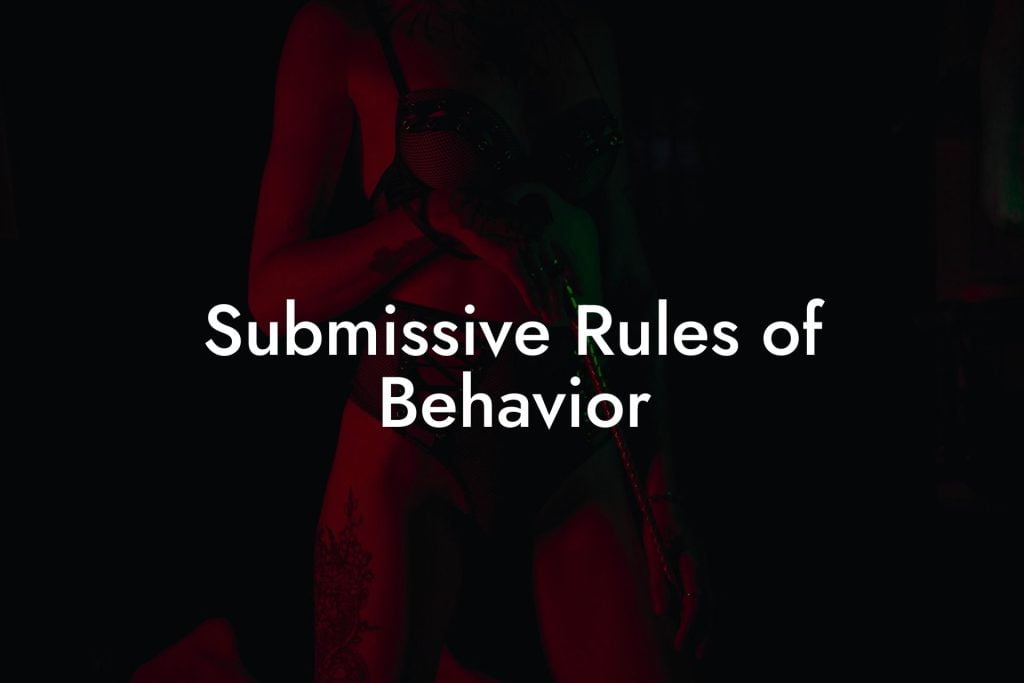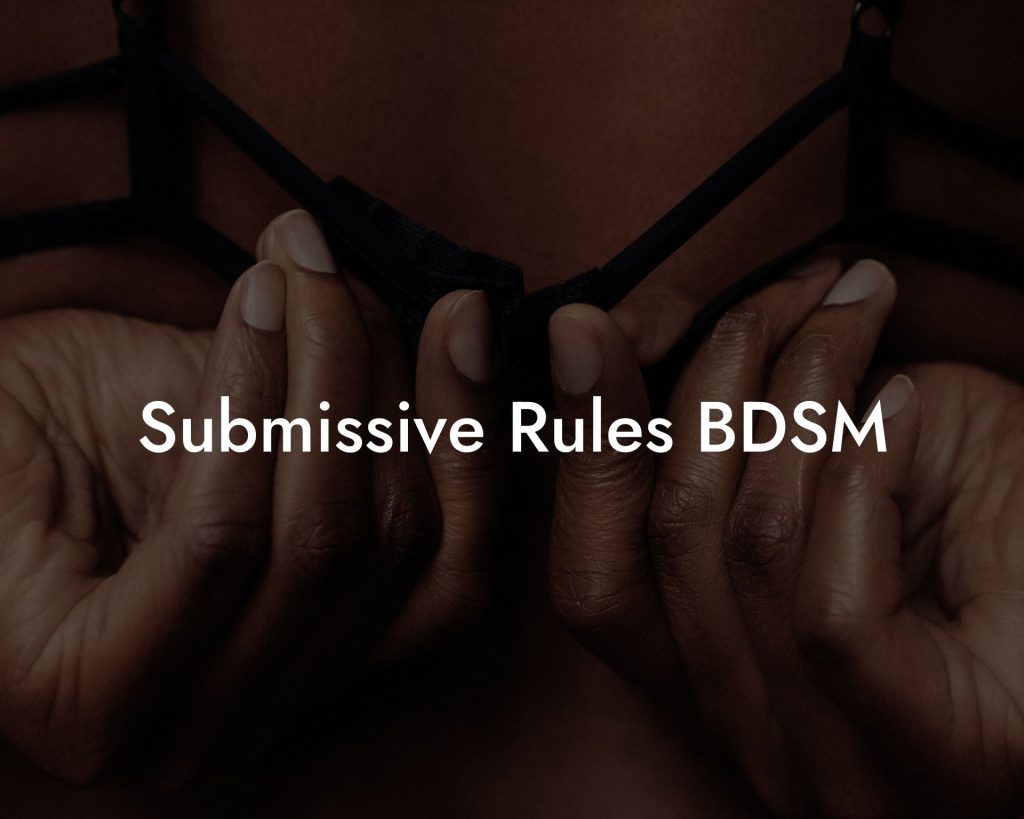BDSM, an acronym that encompasses bondage, discipline, dominance, submission, sadism, and masochism, is a world of exploration and pleasure for many individuals. Whether you are a seasoned practitioner or just starting out on your journey, understanding and respecting boundaries is vital to ensure a safe and consensual experience. In this article, we will delve into the common BDSM limits, shedding light on what beginners need to know and providing insights for those looking to deepen their understanding.
In any BDSM relationship, consent is the cornerstone of trust and respect. It’s more than just saying “yes” or “no”—it’s about openly communicating your desires, limits, and expectations. But trust doesn’t end with a conversation—it’s built through ongoing, clear agreements. That’s where our Dominant & Submissive BDSM Contract Pack comes in. Find out more →
Setting Boundaries
To partake in a BDSM experience, establishing clear and defined boundaries is crucial. Boundaries act as safety nets, protecting participants from venturing into uncomfortable or non-consensual activities. Effective communication is the key to ensuring each participant's limits are respected and upheld. Here are some guidelines for setting boundaries in BDSM:
Communication is Key
Prior to engaging in any BDSM activities, open and honest communication is essential. Discuss your interests, expectations, and any hard limits that must not be crossed. Creating a safe space for open dialogue will foster trust between partners and enhance the overall experience.
Negotiating Limits
During the negotiation phase, partners should discuss and negotiate their limits. A limit is a hard line that should never be crossed, and partners should recognize and respect each other's limits without question. Clearly communicate your limits to avoid any misunderstandings or unforeseen discomfort during play.
Soft Limits and Exploration
While hard limits are non-negotiable, soft limits are activities that may cause discomfort but can be explored within a consensual and controlled environment. It is important to voice any soft limits and communicate consent during the play session to prevent any potential harm or distress.
Looking for the best BDSM & Kink OnlyFans content creators? Here is a list of 10 of our favourites:
- Best Cosplay OnlyFans - 🐱 Little Kitty Kate 👉👌 >> Link
- Best Little OnlyFans - 🧸 Katya 🙇♀️ Sun >> Link
- Best Sub OnlyFans - 🍌Hanna Banana🍌 >> Link
- Best Teen & Huge Tits OnlyFans - ❣️Anny❣️19 y.o. BUSTY student girl >> Link
- Best Tiny Tits OnlyFans - ⍣⭐️ Sofia Parker ⭐️⍣ >> Link
- Best Sub & Huge Boobs OnlyFans - Nika Huge Boobs >> Link
- Best Kink OnlyFans - Julia Pearl🐚 >> Link
- Best Fetish & Girl Next Door OnlyFans - Hillary is Wet 💦 >> Link
- Best Dirty Latina OnlyFans - Paula Flores 😈 >> Link
- Best BBW & Huge Ass OnlyFans - Naughty Hanna Zimmer 💜🎀 >> Link
Not quite what you are looking for? View the full list →
Ongoing Communication
Boundaries and limits can evolve over time, so it is crucial to have ongoing conversations to reassess and redefine boundaries. As participants gain experience and trust, they may feel more comfortable exploring new activities or pushing their limits. Consistent communication ensures a safe and enjoyable BDSM experience for all involved.
Frequently Asked Questions
What is a BDSM contract?
A BDSM contract is a written agreement between the participants in a BDSM relationship or scene. It outlines the roles, expectations, rules, and boundaries of the relationship and is designed to ensure that all activities are consensual and agreed upon by everyone involved. This contract can be formal or informal and may include details such as limits, safe words, and duration of the contract.
Why are BDSM contracts important?
BDSM contracts are important because they promote clear communication and ensure that all parties have a mutual understanding of what is expected. They are tools for negotiating consent and help to establish a framework for trust and safety within the relationship.
Do all BDSM relationships require a contract?
No, not all BDSM relationships require a contract. The use of a contract depends on the preferences of the individuals involved. Some may prefer a verbal agreement or may not use a contract at all, relying on ongoing communication to navigate their dynamic.
Can a BDSM contract be legally binding?
While a BDSM contract can help clarify the intentions and agreements between the parties, it is not typically legally binding. It is more of a symbolic and practical tool for the relationship. However, any illegal acts agreed upon in a BDSM contract remain illegal regardless of the contract's existence.
What are BDSM power dynamics?
BDSM power dynamics refer to the roles of dominance and submission that participants adopt within a BDSM interaction or relationship. These dynamics can be fluid and are often negotiated prior to engagement in BDSM activities. They can range from mild role-playing to full-time power exchange relationships.
How is consent given and managed in a BDSM context?
Consent in a BDSM context is given explicitly, with all parties involved clearly communicating their agreement to participate in certain activities. Consent must be informed, voluntary, and revocable at any time. Safe words and signals are often established as a part of managing ongoing consent during a scene.
What is a safe word, and why is it important?
A safe word is a predetermined word or signal that any participant can use to pause or stop a BDSM scene. It's a crucial safety mechanism that ensures immediate attention to any discomfort or the need to halt the activity for any reason.
How does trust factor into BDSM relationships?
Trust is a fundamental aspect of any BDSM relationship. Participants must trust each other to communicate honestly, respect limits and boundaries, and adhere to the agreed terms of their contract or arrangement. Without trust, the safety and well-being of those involved can be compromised.
Is it necessary to have a safe word even if I trust my partner completely?
Yes, having a safe word is still necessary regardless of trust levels. It provides a clear and direct way to communicate during a scene, especially in cases where a person's capacity to communicate might be affected by their physical or emotional state.
Are there legal considerations to be aware of in a BDSM relationship?
Yes, individuals must be aware of the legal implications of their activities. Consent in BDSM does not exempt participants from legal responsibility, and certain acts may still be considered assault or battery under the law, regardless of consent.
Can BDSM contracts address mental health and aftercare?
Absolutely. BDSM contracts can and should address mental health concerns and outline aftercare arrangements. Aftercare refers to the attention and care given to participants after a scene to ensure their physical and emotional needs are met.
How can individuals practice safe BDSM?
Individuals can practice safe BDSM by thoroughly discussing boundaries, hard limits, and expectations beforehand. They should establish safe words/signals, agree on aftercare procedures, and maintain open and honest communication throughout the relationship.
What if I want to change the terms of my BDSM contract?
The terms of a BDSM contract can be renegotiated at any time. It's vital for all parties to agree to any changes and acknowledge them in writing, ensuring continued consent and understanding.
What are some common misconceptions about BDSM?
Some common misconceptions include the idea that BDSM is inherently abusive, that it stems from past trauma, or that it's only about sex. BDSM is a consensual practice between adults with diverse interests and does not necessarily involve sex or originate from negative experiences.
Why is aftercare important in BDSM?
Aftercare is important because BDSM scenes can be physically and emotionally intense. Aftercare provides a transition from that intensity back to everyday reality, helps prevent subdrop, and reinforces the care and respect between participants.
How can I ensure my BDSM activities are consensual?
Ensure that all activities are consensual by discussing them in detail with your partner(s), obtaining clear affirmative consent, and respecting any limits and boundaries that are set. Regularly check in with your partners before, during, and after scenes to ensure ongoing consent.
What should I do if a safe word is ignored?
If a safe word is ignored, the scene should be stopped immediately, and the safety of the person who used it should be the priority. It's important to reassess the trust and dynamics of the relationship and address the breach of consent seriously, perhaps with the assistance of a mediator or counselor.
Can anyone participate in BDSM?
Anyone above the age of consent and who has the capacity to give informed consent can participate in BDSM. It is essential that participants have a clear understanding of their desires, boundaries, and the nature of the activities they are engaging in.
What is 'subdrop' and 'topdrop,' and how can they be managed?
'Subdrop' and 'topdrop' refer to the physical and emotional lows that can follow the intense highs of a BDSM scene. They can be managed through adequate aftercare, which may include physical comfort, emotional support, and open communication between participants.
Are BDSM practices universally the same?
No, BDSM practices are not universally the same. They vary widely among individuals and cultures, with different practices and customs emerging from their unique contexts. These practices are shaped by personal preferences, physical abilities, and individual limits and boundaries.
Now that you have a deeper understanding of the common BDSM limits, you can embark on your journey with knowledge and confidence. Remember, boundaries are essential for a safe and consensual experience. Explore our Filthy Adult website to delve further into the world of BDSM, order our Ultimate BDSM Contract Pack, read other informative guides, and browse our fetish shop. Share this article with others who may benefit from this valuable information and let's continue to foster a community of exploration and consent in the BDSM world.













